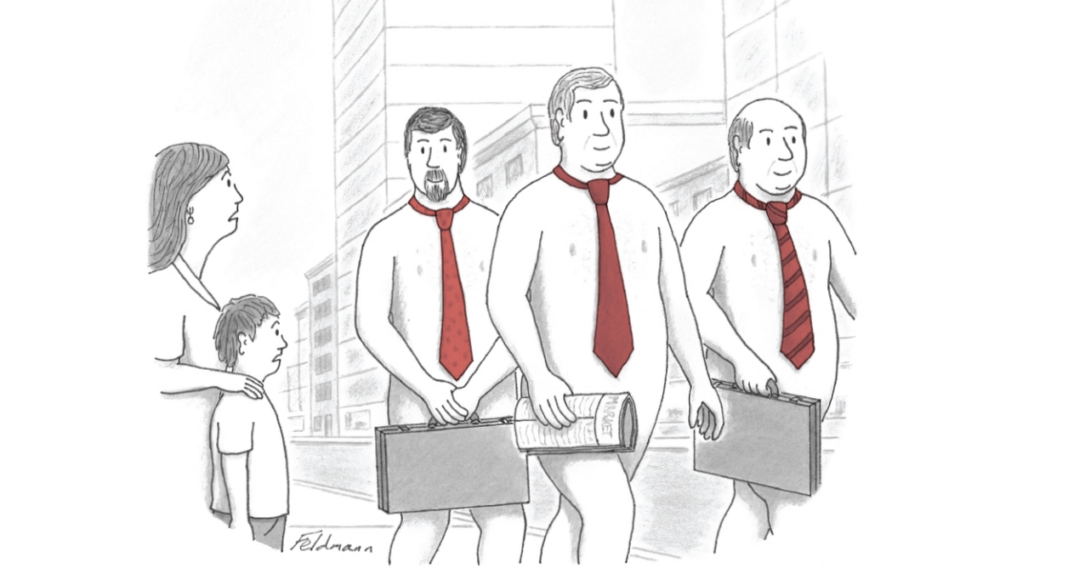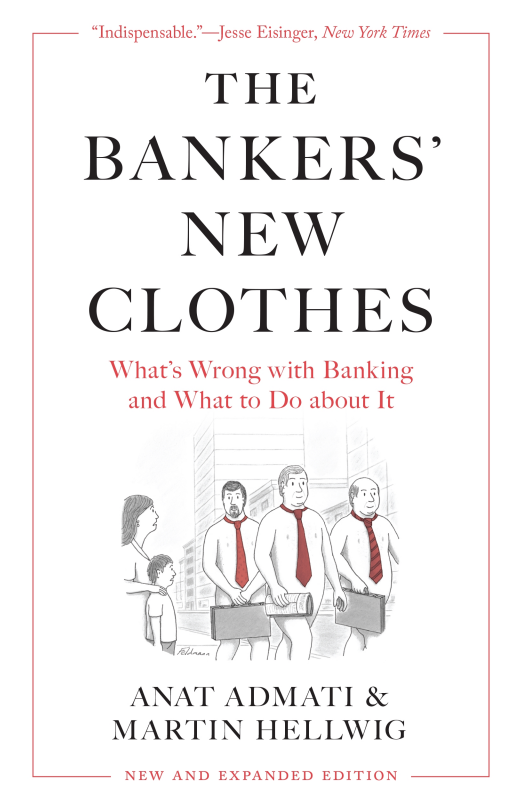The following is an excerpt from the book The Bankers’ New Clothes: What’s Wrong with Banking and What to Do about It – New and Expanded Edition by Anat Admati and Martin Hellwig published by Princeton University Press and reprinted here by permission. Also check out today’s Capitalisn’t interview with Anat Admati.
The global banking system was so fragile in 2007–2009 that it was unable to withstand the impact of the decline in U.S. housing prices. The breakdowns of financial institutions and the declines in asset prices were stopped only when central banks and governments provided massive bailouts and supports. We wrote this book to explain why the system had become so fragile and how it had broken down, and to advocate for better rules. The fragility was the result of distorted incentives and poorly designed rules. Reforms after the crisis did not remove the major flaws. The “reformed” rules were still poorly designed and did little to reduce the fragility of the system. They still enabled bankers to profit at the expense of others. We realized that, without broader understanding and engagement, the politics of banking prevented effective reform. To broaden the set of participants, we sought to cut through the confusing jargon and explain the issues so they are accessible to all. Our title, The Bankers’ New Clothes, indicates that many of the claims made in this discussion are deeply flawed.
Since the book came out in early 2013 we have kept advocating for better rules, but the politics of banking continued to prevent progress. Once public attention was diverted to other subjects, banking regulation even moved backward rather than forward. The absence of a major crisis between 2013 and 2022 made bankers and politicians complacent. They liked to boast that banks are “strong,” that the financial system is safe, and that new rules for dealing with failing banks have eliminated the “too-big-to-fail” problem. However, the seeming stability of financial systems between 2013 and 2022 was due to the favorable overall economic environment after 2013 and to the massive supports that governments and central banks provided to the economy and to asset prices during the COVID pandemic. Moreover, on several occasions the authorities went out of their way to avoid applying the new rules for dealing with failing banks, even for smaller banks. We still have too-big-to-fail institutions. Many of them have become even bigger.
Events in 2023 exposed the promises of “no more bailouts” made by bankers, politicians, and regulators since 2010 as vacuous. The U.S. government provided guarantees for tens of billions in uninsured deposits of the failed Silicon Valley and Signature Banks, and it engaged taxpayers in a loss-sharing agreement with JPMorgan Chase in the sale of the failing First Republic Bank. Many banks may be insolvent, but are kept alive by the Federal Reserve’s new lending programs. Taxpayer-backed guarantees are also involved in the government-engineered takeover of one of two giant banks in Switzerland, Credit Suisse, by the other one, UBS. These events all show that much remains wrong with banking. They took place just as we were finalizing new material for the new edition of the book that we started writing in September 2022. In this edition we discuss events through May 2023 and place them in the context of developments since 2013.
This edition of the book expands our discussion in a few important ways. First, since the 2007–2009 financial crisis, central banks such as the Federal Reserve, the Bank of England, and the European Central Bank have taken an ever larger and more prominent role in the economy. By now, whenever a problem arises they are expected to step in to support financial markets, banks, and others, including governments. Central banks are powerful and prominent. We mentioned them many times in the first edition of this book, but we did not explain how they work and how they interact with private-sector institutions. In this edition we remove much of the mystery around central banks. The interactions of central banks with private-sector institutions, including the role of some central banks as regulators and supervisors, are important for understanding how central banks have enabled and even exacerbated the fragility of the banking system in recent years and how they continue to do so now.
Second, we explain why bailouts by governments and central banks continue and why new rules for dealing with the failing banks are not workable. Despite earlier promises that these rules would end disruptive failures and bailouts, the Swiss authorities ultimately did not entrust Credit Suisse to their own new procedure, which suggests that they shared our assessment. However, the system, and some institutions, may become “too big to save.”
Repeated scandals and breaches of the law in banking raise the question of whether people in banking are above the law. This edition provides a more extensive discussion of issues concerning the rule of law for corporations and their executives, in banking and beyond. When we finished writing the first edition of this book in 2012, the “scandal of the day” involved the so-called LIBOR fraud, coordinated falsifications of reports from banks to the British Bankers Association, which used the reports to construct an interest rate index called LIBOR. This index determined payments in millions of contracts around the world. Prosecution of LIBOR falsifications and many other cases of wrongdoing by financial institutions and people working for them has been very weak. To the best of our knowledge, except in Iceland, none of the top executives of the institutions involved ever faced criminal prosecution. Civil liability, such as clawbacks of bonuses and payments for damages, was hardly ever imposed.
In this edition we discuss why violations of rules could have become a normal way of doing business in banks. Bankers routinely infringe internal rules intended to limit risks without reprimands from their superiors. They also break laws against fraud, price fixing, and money laundering with scant interference from authorities. Regulators and supervisors, auditors and rating agencies are often blind, perhaps willfully blind, to rule breaking. Law enforcement authorities may impose seemingly large fines on banks, but these fines may still be small compared to the gains from the incriminated practices. Moreover, the fines are often parts of settlements that allow banks to claim that they did nothing wrong and that reveal little relevant information to the public. Many in the media and in academia are fascinated by the glamor of bank bosses and extoll the “efficiency” of banking while overlooking the enormous harms it has caused and is still causing.
In this new edition, we maintain the original text, which remains relevant just as it is, and which covers the issues and events through 2012. The new chapters reflect experiences since 2013, including our own extensive engagements with many people in the private sector, the policy world, and academia, as well as our service on advisory bodies of regulatory institutions. These activities have improved our understanding of how political institutions and authorities interact with the industry, the media, and academics. They have also forced us to pay more attention to the details of rules set by legislators and regulators and the nuances associated with enforcement, and to relate these details to our own analysis.
The decade since the book first came out leaves us even more alarmed by the state of our democracies in dealing with powerful corporations and their leaders. The power of financial institutions to influence, in public or behind closed doors, how laws and regulations are written and enforced contributes to the disaffection of many with our political, economic, and legal systems. Fooling others and perhaps oneself, both in trading and in political discussion, is pervasive in banking and far beyond. The challenge is to give truth more power.
Articles represent the opinions of their writers, not necessarily those of the University of Chicago, the Booth School of Business, or its faculty.







